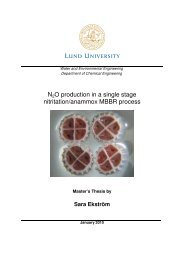Alexander Szabo and Oscar Engle - Svenskt Vatten
Alexander Szabo and Oscar Engle - Svenskt Vatten
Alexander Szabo and Oscar Engle - Svenskt Vatten
Create successful ePaper yourself
Turn your PDF publications into a flip-book with our unique Google optimized e-Paper software.
the case of waste water treatment ponds, the algae are the main producers of oxygen (Shilton et<br />
al., 2005). Since the algae are only present in the upper part of a pond, it is difficult to achieve<br />
aerobic decomposition through an entire pond. There are however more advanced pond systems<br />
where algae are mixed through the water to oxygenate larger volumes. In mechanically aerated<br />
ponds, oxygen is pumped or mixed into the water which will achieve high dissolved oxygen<br />
levels. The disadvantage of mechanical oxygen support is that it consumes large amounts of<br />
energy.<br />
Aerobic degradation in waste water treatment ponds requires larger volumes <strong>and</strong> a longer<br />
retention time then the conventional activated sludge-systems, because the concentrations of<br />
active biomass, containing the microorganisms, are much lower.<br />
Anaerobic degradation<br />
When no oxygen is available, anaerobic degradation may occur by anaerobic microorganisms.<br />
The benefit of anaerobic digestion is that it can deal with highly concentrated waste water <strong>and</strong> can<br />
achieve good purification results within short retention times. The process is temperature<br />
dependent <strong>and</strong> will, if properly designed, reduce the BOD concentrations by 40% at 10°C, 60% at<br />
20°C <strong>and</strong> 70% at 25°C (Shilton et al., 2005). The anaerobic pond should be installed as the first<br />
treatment step, when the load of waste water is the highest. The high load of organic matter<br />
would inhibit the presence of algae. A typical anaerobic pond receives more than 3000 kg<br />
BOD/ha/day, whereas facultative ponds should not receive more than 400 kg BOD 5 /ha/day in<br />
order to sustain a healthy algal population (Mara, 2003).<br />
Sedimentation<br />
Large amounts of settleable <strong>and</strong> flocculated colloidal materials that enter the pond will settle to<br />
the bottom of the pond <strong>and</strong> create a sludge layer as the water speed declines. Independent of<br />
whether the particles settle in an anaerobic or facultative pond, the environment, within the<br />
formed sludge layer, will be anaerobic. Even maturation ponds, which are at the last step of the<br />
treatment, may produce a thin anaerobic sludge layer at the bottom. The sludge layer is broken<br />
down anaerobically <strong>and</strong> thickens over time. Gases (methane <strong>and</strong> carbon dioxide) that result from<br />
the degradation arises up though the water <strong>and</strong> escapes into the atmosphere. It is estimated that up<br />
to 30% of the BOD load disappears as gas (Shilton et al., 2005).<br />
Disinfection<br />
There are several factors within a WSP that together contribute to the removal of illness-causing<br />
bacteria, viruses, worms <strong>and</strong> protozoan parasites. It is however difficult to exactly evaluate the<br />
contribution to the disinfection effect from a single factor, since the processes within a WSP are<br />
both complex <strong>and</strong> dynamic. Factors that are known to contribute to disinfection are sunlight (UV)<br />
exposure, pH, temperature, algal toxins, sedimentation <strong>and</strong> hydraulic retention time (Shilton et<br />
al., 2005). The WSP:s are generally considered very good at removal of pathogens (Maynard et<br />
al., 1999). Research about disinfection shows treatment results from 26 WSP:s around the world<br />
(see Table H.1, Appendix H). The reduction performance of pathogens in WSP systems is<br />
<br />
19















